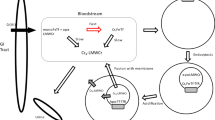Abstract
Human transferrin (Tf) very tightly binds two ferric ions to deliver iron to cells. Fe(III)2Tf (Fe2Tf) binds to the Tf receptor (TfR) at pH 7.4; however, iron-free Tf (apoTf) does not. Iron uptake is facilitated by endocytosis of the Fe2Tf–TfR complex. Tf can also bind aluminum ions, which cause toxic effects and are associated with many diseases. Since Al(III)2Tf (Al2Tf) does not bind to TfR, the uptake of aluminum by the cells does not occur through a TfR-mediated pathway. We have studied the absence of binding between Al2Tf and TfR by investigating the physicochemical characteristics of apoTf, Al2Tf, Fe2Tf, and TfR. The hydrodynamic radius of 38.8 Å for Al2Tf obtained by dynamic light scattering was between that of 42.6 Å for apoTf and 37.2 Å for Fe2Tf. The ζ potential of −11.3 mV for Al2Tf measured by capillary electrophoresis was close to −11.2 mV for apoTf as compared to −11.9 mV for Fe2Tf, indicating that the Al2Tf surface had a relatively scarce negative charge as the apoTf surface had. These results demonstrated that the structure of Al2Tf was a trade-off between the closed and open forms of Fe2Tf and apoTf, respectively. Consequently, it is suggested that Al2Tf cannot form specific ionic interresidual interactions, such as those formed by Fe2Tf, to bind to TfR, resulting in impossible complex formation between Al2Tf and TfR.

Similar content being viewed by others
References
Kawahara M, Konoha K, Nagata T, Sadakane Y (2007) Aluminum and human health: its intake, bioavailability and neurotoxieity. Boimed Res Trace Elements 18:211–220
McGregor SJ, Naves ML, Oria R, Vass JK, Brock JH (1990) Effect of aluminum on iron uptake and transferrin-receptor expression by human erythroleukemia K562 cells. Biochem J 272:377–382
Martin RB (1994) Aluminum—a neurotoxic product of acid-rain. Acc Chem Res 27:204–210
Abreo K, Abreo F, Sella M, Jain S (1999) Aluminum enhances iron uptake and expression of neurofibrillary tangle protein in neuroblastoma cells. J Neurochem 72:2059–2064
Yokel RA, Allen DD, Ackley DC (1999) The distribution of aluminum into and out of the brain. J Inorg Biochem 76:127–132
Yokel RA (2000) The toxicology of aluminum in the brain: a review. Neurotoxicology 21:813–828
Yokel RA, McNamara PJ (2001) Aluminium toxicokinetics: an updated MiniReview. Pharmacol & Toxicol 88:159–167
Clauberg M, Joshi JG (1993) Regulation of serine protease activity by aluminum—implications for Alzheimer-disease. Proc Natl Acad Sci USA 90:1009–1012
Brock JH (1985) Transferrins. Macmillan, London
Crichton R (2001) Inorganic biochemistry of iron metabolism. Wiley, Chichester
Aisen P, Harris DC (1989) Iron carriers and iron proteins. VCH, New York
Ichimura K, Kihara H, Yamamura T, Satake K (1989) Negative cooperativity of chicken ovotransferrin on Al(III)-binding. J Biochem 106:50–54
Harris WR (1988) Equilibrium-constants for the complexation of metal-ions by serum transferrin. Abstr Pap Am Chem Soc 249:67–93
Harris WR (1998) Binding and transport of nonferrous metals by serum transferrin. Springer, Berlin
Chasteen ND (1977) Human serotransferrin: structure and function. Coord Chem Rev 22:1–36
Lawrence CM, Ray S, Babyonyshev M, Galluser R, Borhani DW, Harrison SC (1999) Crystal structure of the ectodomain of human transferrin receptor. Science 286:779–782
Aisen P, Enns C, Wessling-Resnick M (2001) Chemistry and biology of eukaryotic iron metabolism. Int J Biochem Cell Biol 33:940–959
Enns CA, Sussman HH (1981) Physical characterization of the transferrin receptor in human placentae. J Biol Chem 256:9820–9823
Zak O, Aisen P (2003) Iron release from transferrin, its C-lobe, and their complexes with transferrin receptor: presence of N-lobe accelerates release from C-lobe at endosomal pH. Biochemistry 42:12330–12334
Dautryvarsat A, Ciechanover A, Lodish HF (1983) pH and the recycling of transferrin during receptor-mediated endocytosis. Proc Natl Acad Sci USA 80:2258–2262
Chikh Z, Ha-Duong NT, Miquel G, Chahine JME (2007) Gallium uptake by transferrin and interaction with receptor 1. J Biol Inorg Chem 12:90–100
Chikh Z, Hemadi M, Miquel G, Ha-Duong NT, Chahine J (2008) Cobalt and the iron acquisition pathway: competition towards interaction with receptor 1. J Mol Biol 380:900–916
Miquel G, Nekaa T, Kahn PH, Hernadi M, Chahine JME (2004) Mechanism of formation of the complex between transferrin and bismuth, and interaction with transferrin receptor 1. Biochemistry 43:14722–14731
Hemadi M, Miquel G, Kahn PH, Chahine JME (2003) Aluminum exchange between citrate and human serum transferrin and interaction with transferrin receptor 1. Biochemistry 42:3120–3130
Kohgo Y, Torimoto Y, Kato J (2002) Transferrin receptor in tissue and serum: updated clinical significance of soluble receptor. Int J Hematol 76:213–218
Kohgo Y, Niitsu Y, Nishisato T, Urushizaki Y, Kondo H, Fukushima H, Tsushima N, Urushizaki I (1985) Transferrin receptors of tumor cells—potential tools for diagnosis and treatment of malignancies. Elsevier, Amsterdam
Aisen P, Aasa R, Malmstro Bg, Vanngard T (1967) Bicarbonate and binding of iron to transferrin. J Biol Chem 242:2484–2490
Yajima H, Sakajiri T, Kikuchi T, Morita M, Ishii T (2000) Molecular modeling of human serum transferrin for rationalizing the changes in its physicochemical properties induced by iron binding. Implication of the mechanism of binding to its receptor. J Protein Chem 19:215–223
Wally J, Halbrooks PJ, Vonrhein C, Rould MA, Everse SJ, Mason AB, Buchanan SK (2006) The crystal structure of iron-free human serum transferrin provides insight into inter-lobe communication and receptor binding. J Biol Chem 281:24934–24944
Author information
Authors and Affiliations
Corresponding author
Rights and permissions
About this article
Cite this article
Sakajiri, T., Yamamura, T., Kikuchi, T. et al. Absence of Binding Between the Human Transferrin Receptor and the Transferrin Complex of Biological Toxic Trace Element, Aluminum, Because of an Incomplete Open/Closed Form of the Complex. Biol Trace Elem Res 136, 279–286 (2010). https://doi.org/10.1007/s12011-009-8547-y
Received:
Accepted:
Published:
Issue Date:
DOI: https://doi.org/10.1007/s12011-009-8547-y




